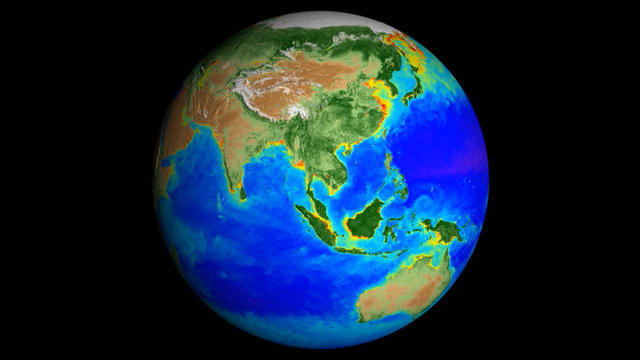by Kelly R Estilette
"You are your own worst enemy" Proverbs 29:24
An "invasive
species" is defined as a species that is: 1) non-native (or alien) to the
ecosystem under consideration and 2) whose introduction causes or is likely to
cause economic or environmental harm or harm to human health. Invasive species
can be plants, animals, and other organisms (NISIC-What Is An Invasive Species,
2016). I have spent years studying science, often learning details of the
damage done to various parts of our world by invasive species and the different
ways to combat them. My studies have culminated in my realization that the
cardinal invasive species, is us. Here I dissect the definition of invasive
species with regard to human activity.
Non-native or alien to
the ecosystem under consideration is the first determination of an invasive
species. What ecosystem is “native” to humans? Current genetic evidence implies
original dispersal of humans from a single Siberian population toward the
Bering Land Bridge no earlier than about 30,000 years ago (and possibly after
22,000 years ago), then migration from Beringia to the Americas sometime after
16,500 years ago (The Late Pleistocene
Dispersal of Modern Humans in the Americas, 2008). Fast-forward to now, 43% of earth's land surface is covered by humans (Map of Human Migration, 2005). Based
on this information, most of Earth’s surface is now covered with humans that
arrived there as aliens to the ecosystem.
Economic harm due to the species introduction into
an ecosystem is the next characteristic of an invasive species examined. In the
case of humans, the economic
impact of global warming is costing the world more than $1.2 trillion a year,
wiping 1.6% annually from global GDP. By
2030, the researchers estimate, the cost of climate change and air pollution
combined will rise to 3.2% of global GDP, with the world's least developed
countries forecast to bear the brunt, suffering losses of up to 11% of their GDP
(Climate change is already damaging global economy, report finds, 2012).
The next requirement of an invasive species is the likelihood
of causing environmental harm. Research shows that humans’
simple, physical presence in a habitat is more damaging than one of the
twentieth century’s worst environmental catastrophes, Chernobyl (Do Humans Cause More Environmental Damage than a Nuclear
Disaster? 2015). The primary
causes behind declining global biodiversity include habitat loss and
fragmentation as a result of human activity. Even some of our most well-meaning
environmental efforts, such as the fight against climate change, have led to
the expansion of the human presence into previously untouched wilderness.
Demand for biofuels, for example, has been linked to deforestation. A further
atrocity at the hands of humans are the intentional acts of environmental
destruction such as nuclear weapons tests and chemical weapons usage (such as
agent orange use in Vietnam) as these tests/uses are intentionally meant to
cause widespread devastation and have severe environmental impacts. A rupture
from a defective dam containing gold and copper mining “tailings” sent tons of
heavy metal wastes and around 120,000 cubic meters of water saturated with
cyanide into the Somes, Tisza and Danube rivers. Massive loss of aquatic life
was documented, especially in neighboring Hungary and Serbia, Test of river
water and sediments after the accident, found cyanide levels between 300 and
700 times above pollution standards. Copper and zinc concentrations also
exceeded by many times “safe” pollution thresholds. Exposed metal ore tailings,
when dry, can produce toxic dust. To reduce this problem, and to extract any
remaining gold, the process of gold cyanidation is employed, which uses cyanide
to extract any gold traces from mineral ores. The by-product of this
controversial process is vast quantities of cyanide-laced water and heavy metal
waste. Cyanide is a highly lethal
chemical. There are thousands of mining waste dumps (many without dam
containment) scattered all over the world, most situated near streams, rivers
and large bodies of water (PlanetSave, 2010). The list of examples is unending,
in fact, according to a recent analysis by
Trucost, the estimated cost of environmental damage caused by human activity
reached $6.6 trillion in 2008, or 11 percent of the global Gross Domestic
Product (GDP) (Humans Caused $6.6 Trillion in Environmental Damage in 2008,
2010).
Human health, our
fellow species health and environmental health are undeniably bound together. It
is our responsibility as the cardinal invasive species of this world to utilize
our higher order thinking and processing power to learn from our surroundings,
respect our environment and cease the madness.
Works
Cited
Center, National Invasive Species Information.
“About NISIC - What Is an Invasive Species?” National Invasive Species
Information Center, 24 May 2016, www.invasivespeciesinfo.gov/whatis.shtml.
Genographic Project. “Map of Human Migration.”
Genographic Project, 2005, genographic.nationalgeographic.com/human-journey/.
Harvey, Fiona. “Climate Change Is Already Damaging
Global Economy, Report Finds.” The Guardian, Guardian News and Media, 26 Sept.
2012, www.theguardian.com/environment/2012/sep/26/climate-change-damaging-global-economy.
Kropp, Robert. “Humans
Caused $6.6 Trillion in Environmental Damage in 2008.” GreenBiz, GreenBiz
Group Inc., 5 Oct. 2010,
www.greenbiz.com/news/2010/10/05/humans-caused-66-trillion-environmental-damage-2008.
Smith, Jim T. “Do Humans Cause More Environmental
Damage than a Nuclear Disaster?” World Economic Forum, 22 Dec. 2015,
www.weforum.org/agenda/2015/12/do-humans-cause-more-environmental-damage-than-a-nuclear-disaster/.
“Top 13 Human-Caused Environmental Horrors.”
PlanetSave, 24 Oct. 2010,
planetsave.com/2010/10/24/top-13-human-cause-environmental-horrors/.
The Late
Pleistocene Dispersal Of Modern Humans In The Americas
By Ted
Goebel, Michael R. Waters, Dennis H. O'rourke
Science14 Mar 2008: 1497-1502

No comments:
Post a Comment